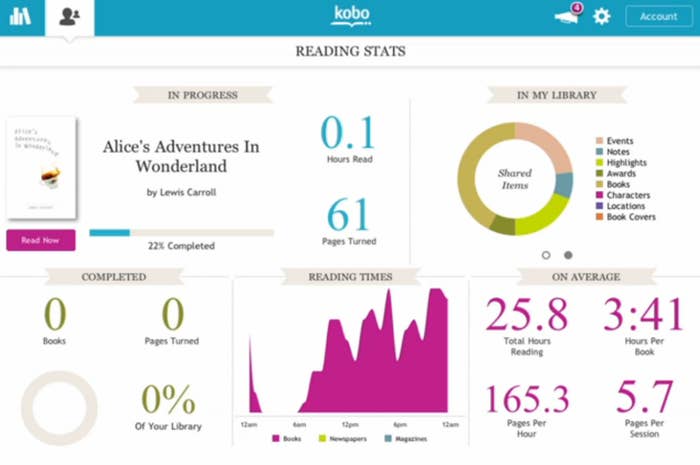
Millions may have held their suspicions, but last month the Canadian e-reader company Kobo confirmed it: Most people who buy The Goldfinch don't actually finish it. According to the company's data, less than half of Canadian and British Kobo readers in 2014 made it to the end of Donna Tartt's behemoth novel, one of the best-selling of the year.
How did Kobo know this? Like every e-reader and reading-app maker today, the company, a subsidiary of the Japanese e-commerce titan Rakuten, has access to a comprehensive suite of data about the reading behavior of its users. In a white paper titled "Publishing in the Era of Big Data" and released this fall, the company announced that "with the onset of digital reading ... it is now possible to know how a customer engages with the book itself — what books were left unopened, which were read to the very last word and how quickly." In other words, if you read books digitally, the people who serve you those books more than likely know just what kind of reader you are, and just how little effort you made with Infinite Jest.
The paper was a rare peek into the nascent world of reader engagement analytics, which have been a staple of web publishing but which the big legacy book publishers have been slow to embrace. It was fascinating, not just for the insights it offered into reading behavior (Did you know the industry standard finish rate for mystery books is 62%? Now you do!) but because the enormous corporations — Amazon and Apple — that know the most about how you read are ferociously silent about that knowledge. Both Apple and Amazon declined to comment for this piece.
The findings precipitated a now-predictable response from the loftier perches of the publishing world. In a leery New York Review of Books blog post, titled "They're Watching What You Read," the novelist Francine Prose wrote, "...writers (and their editors) could soon be facing meetings in which the marketing department informs them that 82 percent of readers lost interest in their memoir on page 272. And if they want to be published in the future, whatever happens on that page should never be repeated."
(This kind of rhetoric is nothing new. In a 2012 Wall Street Journal article bearing the similarly alarming headline "Your E-Book Is Reading You," Jonathan Galassi, the president and publisher of Farrar, Straus & Giroux, declared, "We're not going to shorten 'War and Peace' because someone didn't finish it.")
It's true that engagement analytics pose a highly abstract threat to a certain idealized kind of furrowed-brow, human-and-their-word-processor, Great Novel writing and reading, as well as to those people whose livelihoods and self-images are invested in that ideal. ("Excuse me, Mr. Joyce, you're losing a lot of Kindle Fire readers here in this third section. Maybe tighten it up a smidge?") But it's also true that most books released by the declining publishing industry are hardly War and Peace, that so far these numbers have played almost no role in editing and acquisitions in the publishing industry, that they have far greater implications for marketers than they do for writers and editors, and that the companies making the most significant use of engagement analytics aren't traditional publishing houses, but startups.
According to Claudia Ballard, a book agent with William Morris Endeavor, there is still only one salient number when it comes to the books that get picked up.
"The truth of the matter is people have been picking up books and not finishing them for a long time," Ballard told BuzzFeed News. "At the end of the day, a unit sold is still a unit sold."
Editors at several major publishing houses, who spoke to BuzzFeed News on background, agreed. While these editors were aware that engagement analytics exist, and were aware that their sales departments had some form of access to them (though it's still unclear both how much reader engagement data Apple and Amazon collect, and how much of it they share with publishers, including those, in Amazon's case, of their own imprint), they all said these numbers had nothing to do with acquisitions or editing.
Could that change? Well, for engagement to rival sales purely as a measure of commercial importance, and as a factor in acquisitions and editing, books would have to be monetized in a much different way: namely, in-book ads. These kinds of experimental ads have been tried, and, according to independent publishing entrepreneur Richard Nash, they've mostly failed.
"As best as anyone can tell, it has to do with the fact that the average book is read by not that many people," Nash told BuzzFeed News. "Advertising is a volume business and there's not that much to sell when you're talking about 18,000 eyeballs."
That's not to say that editors don't want to see them, and not for purely financial reasons. To use Prose's example, if everyone is stopping on page 272, well, maybe there's an editorial problem on page 272!
If engagement analytics hold actual actionable advice for big publishers today, though, it probably has more to do with figuring out which books to promote and how to promote them, rather than how to edit them or which ones to acquire. In a section called "Identifying the next Dan Brown," the Kobo paper points specifically to the case of so-called "midlist" writers (those who sell well, or garner critical acclaim, but are not major money makers) with high engagement rates as inadequately marketed.
A major factor in the failure to complete books is, of course, lack of time. Safari, a platform for professional education books (it's wholly owned by O'Reilly Media, which publishes coding tutorials), aggregates reading data to point users to relevant sections in separate books. It's easy to imagine this model being applied to mainstream books, especially in non-narrative and nonfiction titles. (Say, a collection of highly read jambalaya recipes pulled from 20 different cookbooks.)
Last year, the publishing giant Macmillan announced Next Big Book, a collaboration with the analytics company Next Big Sound — which tracks sales, publicity, social media activity, and traffic stats (among other things) — to determine which of these factors is most influential in driving a book's popularity. (It doesn't yet include engagement metrics in its analytics, though Next Big Sound CEO Alexander White told BuzzFeed News that it may eventually.) And Macmillan has started to distribute some of this data to writers. So it's not impossible to imagine a point at which writers commonly have access to engagement data.
Would this, as Prose fears, change the way writers write? Of course, most authors have never seen engagement statistics for their work. But Eli Horowitz, formerly the managing editor of McSweeney's and now a founder of the mobile storytelling startup Ying, Horowitz and Quinn, had access to reader data for The Silent History, a serialized digital novel that he co-wrote. Yet after the project was complete, Horowitz and his co-creators actually spent very little time with the data for pretty understandable reasons: lack of time, and fatigue.
"We didn't do it because we had other stuff to do and the book was written," Horowitz told BuzzFeed News. Asked if the data might prove useful for future projects, Horowitz said no, because "I don't want to write that novel again."
Indeed, using any data — even sales data — to futurecast in publishing has always been a dangerous prospect because of years-long lead times and the personal investment involved in writing a book. Trends change, and writers move on. "It's not a quick post the author is going to jot off," Ballard, the book agent, said. "They have to live with a book for years or a decade. To live in that space for that long you have to be mentally prepared to have all sorts of feelings about it, and you have to really want to write it, not simply because you think people will want to read it. That place of passion is always where good books come from."
So don't expect Prose's page 272 scenario anytime in the near future, if at all. Of engagement-based editing, Nash said, "We haven't seen anything yet and I'm skeptical that we'll end up with much. Not even Netflix, which is deeply interested in analytics, was telling Kevin Spacey how to act [in House of Cards]."

What Netflix can do (and famously does), however, is promote titles to viewers based on measures both explicit (the movies they rate highly) and implicit (the movies they watch/finish). And it's in exactly those ways that reader engagement analytics may play a much stronger role in a future in which Amazon's hold on digital reading loosens. (Or at least loosens somewhat. It's still Amazon.) A new generation of subscription apps, including Scribd and Oyster, for which readers pay a monthly fee in exchange for access to massive libraries, and Rooster, a commute-reading app that serves readers piecemeal portions of longer works, are already using analytics to understand their customers.
Oyster, which charges $10 for a month of access to 1 million books, uses analytics-based algorithms to serve new recommendations to its audience. According to Eric Stromberg, the company's co-founder and CEO, 80% of new books found by readers come through discovery rather than a targeted search. And Oyster uses finishing rate as one of the metrics to determine which books to recommend.
"If you open a number of books and close them right away that's a signal that you don't want to read that type of book," Stromberg told BuzzFeed News.
Scribd, Oyster's competitor, uses engagement analytics as a way of quantifying the value of the titles they license: The company's co-founder, Jared Friedman, says Scribd pays publishers when customers read more than a certain percentage of a book.
The idea with both of these services is to figure out what readers want and then to give them much, much more of it. Here, the most significant threat to furrowed-brow writing and reading emerges. It's not that an army of profit-starved editors will cut the most difficult and rewarding part of the next Great Difficult Novel, but that the super-sophisticated recommendation engines that power our reading apps will think, with no small amount of evidence, that we don't want to read it.
Perhaps with this prospect in mind, Oyster funds an online literary journal, the Oyster Review, which pleasingly resembles other literary reviews, and features an about section — "a modern literary magazine about a life well read" — complete with precious adjective placement.
Rooster, the commute-reading app, is also finding ways to mix "class and math," says the service's founder, Jennifer 8. Lee. While the company runs A/B tests on reading rates for different versions of digital book covers, in addition to more traditional engagement analytics like read-through rates, Lee told BuzzFeed News that "so many things matter more, like getting a Nobel Prize winner or a Booker Prize winner."
In addition to the publishers, authors, editors, and publishing startups, there's one more group that might have a particular interest in engagement statistics: readers themselves. Kobo's Reading Life — which has been around for quite a while — gives readers access to some of the very information that the doyens of the publishing industry find so objectionable. This is the kind of quantified self data that people are increasingly addicting themselves to, and, frankly, it's an area in which it's hard to see the downside. Among Kobo's stats: Total time spent reading, a statistic that everyone, from Francine Prose to the most efficiency-obsessed digital publishing marketer to those of us with shamefully neglected copies of The Goldfinch languishing in our digital libraries, would like to see go up.
